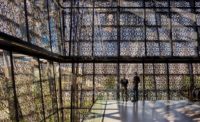The National Building Museum recently announced that it will receive a collected body of images as a gift from architectural photographer Alan Karchmer, whose comprehensive portfolio includes striking images of the Equal Justice Initiative’s National Memorial for Peace and Justice and the David Adjaye-designed National Museum of African American History and Culture. The collection features photos of projects in the United States and abroad, and several will be on display in a yet-to-be-announced exhibition. “Alan’s eye and patience always give the viewer the essential perspective of whatever he photographs,” said the museum’s executive director Chase Rynd. “These photographs will contribute greatly to our collection’s currency, and enhance its usefulness to future scholars, historians, and practitioners.”
Karchmer’s work will be presented as part of an exploration into the inner workings of architectural photography. The museum hopes the exhibition will give visitors a better understanding of the photographer’s creative vision and the inspiration behind the works he has captured. “[The] publication [of these photos] gives me a voice in the conversations presented by journals like Architectural Record,” said Karchmer. “A photographer’s commentary is implied in the image. A photograph may appear to be objective but reflects a critical point of view.”
Karchmer taught himself how to take photos of buildings while studying architecture at Tulane University, where he would earn his Master’s degree in 1978. In 1990, he moved to Washington, D.C., where he and his wife, photo stylist Sandra Benedum, have worked in collaboration since. Some of the photographer’s reportage includes works by leading architects like Santiago Calatrava and Tadao Ando. Karchmer has also photographed the Calatrava-designed Auditorio de Tenerife in Spain (which RECORD featured on the cover of its February 2004 issue) and World Trade Center Transportation Hub. “I was drawn to study architecture with the intention of becoming an architect,” he explained. “I discovered a natural talent for using a camera as a tool for interpreting design.”













